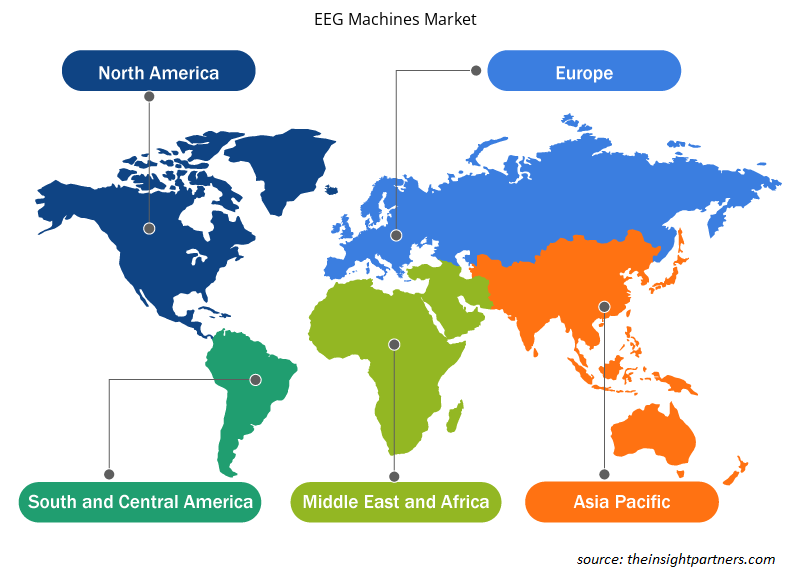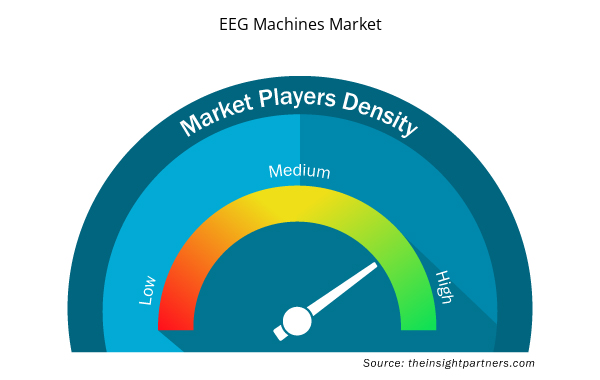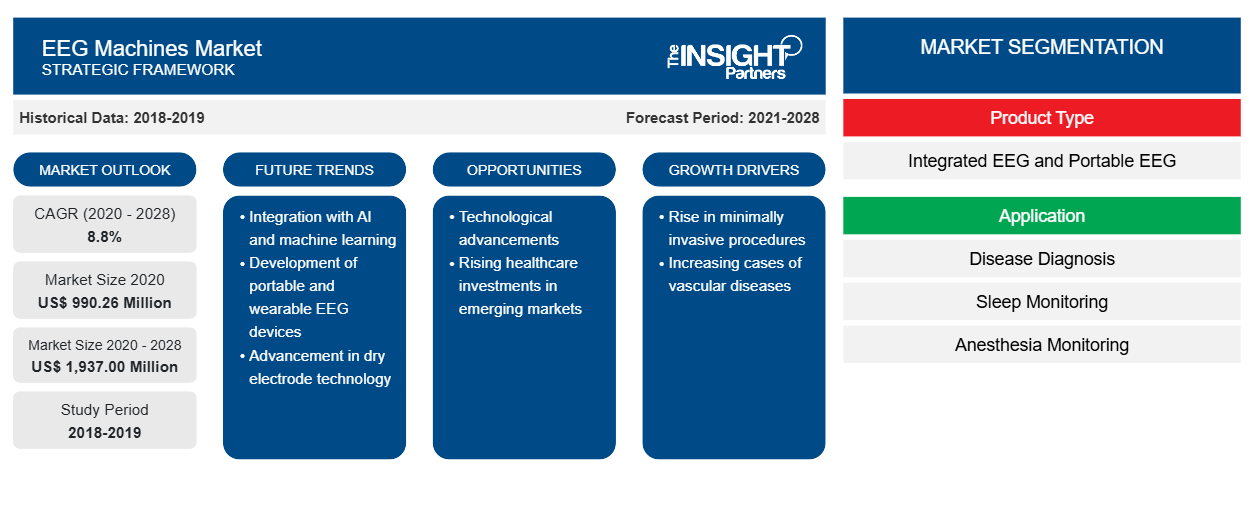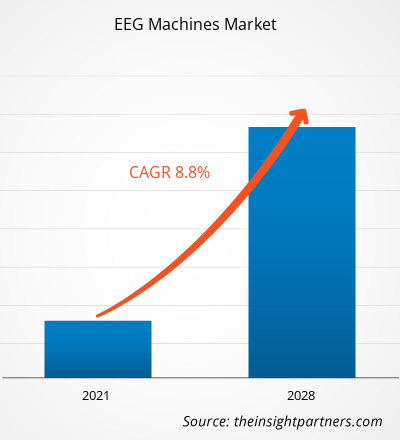[Informe de investigación] El mercado de máquinas EEG se valoró en US$ 990,26 millones en 2020 y se proyecta que alcance los US$ 1.937,00 millones para 2028; se espera que crezca a una CAGR del 8,8% entre 2021 y 2028.
Un electroencefalógrafo (EEG) es un dispositivo médico que ayuda a los profesionales médicos a controlar las señales eléctricas del cerebro. Las señales eléctricas transmitidas son relativamente débiles y, por lo tanto, requieren amplificación. Se utiliza un amplificador para aumentar el voltaje. Las lecturas de un dispositivo de EEG se utilizan para diagnosticar diversos trastornos neurológicos y controlar los trastornos del sueño y a los pacientes bajo anestesia durante procedimientos médicos como la cirugía. El equipo funciona con la ayuda de electrodos adheridos al cuero cabelludo para recopilar la lectura de las ondas cerebrales. El equipo de EEG se utiliza principalmente en hospitales, laboratorios de diagnóstico y centros de cirugía ambulatoria.
El mercado de las máquinas de EEG está segmentado en función del tipo de producto, la aplicación, el usuario final y la geografía. Según la geografía, el mercado está segmentado en América del Norte, Europa, Asia Pacífico, Oriente Medio y África, y América del Sur y Central. El informe ofrece información y un análisis en profundidad del mercado de las máquinas de EEG haciendo hincapié en varios parámetros, como las tendencias del mercado, los avances tecnológicos, la dinámica del mercado y el análisis del panorama competitivo de los principales actores del mercado en todo el mundo. También incluye un análisis del impacto de COVID-19 en todas las regiones. Se estima que es probable que el mercado tenga una tasa de crecimiento más lenta durante el período de pronóstico debido a los servicios de salud restringidos y la situación de bloqueo causada por la pandemia de COVID-19.
Personalice este informe según sus necesidades
Obtendrá personalización en cualquier informe, sin cargo, incluidas partes de este informe o análisis a nivel de país, paquete de datos de Excel, así como también grandes ofertas y descuentos para empresas emergentes y universidades.
- Obtenga las principales tendencias clave del mercado de este informe.Esta muestra GRATUITA incluirá análisis de datos, desde tendencias del mercado hasta estimaciones y pronósticos.
Perspectivas del mercado
Aumento de los trastornos neurológicos
La incidencia de trastornos neurológicos está aumentando entre las personas mayores. Sin embargo, debido a diversos factores como el estrés, las mutaciones genéticas, los hábitos de vida y las enfermedades crónicas relacionadas, la incidencia se observa entre personas de todos los grupos de edad. Se estima que existen más de 600 trastornos neurológicos, entre los que se encuentran el Parkinson, el Huntington, el Alzheimer, la distrofia muscular, los accidentes cerebrovasculares, la meningitis, la epilepsia, las demencias, la migraña y los tumores cerebrales.
Según el informe Global Burden of Disease, publicado en JAMA Neurology 2017, en Estados Unidos se estudiaron los años de vida ajustados por discapacidad (AVAD) de las enfermedades más graves, como el ictus, la migraña, la enfermedad de Alzheimer y otras demencias. Los AVAD para el ictus fueron de 3,58 millones, para la enfermedad de Alzheimer y otras demencias de 2,55 millones, y para la migraña de 2,4 millones. Se estima que es probable que la incidencia aumente en el futuro, con la tasa de incidencia de la meningitis (44,8%), la lesión cerebral traumática (44,8%), la lesión de la médula espinal (29,1%) y la encefalitis (38,5%).
De manera similar, se espera que la creciente población geriátrica influya en la incidencia de trastornos neurológicos. Según el informe de la Organización Mundial de la Salud (OMS) publicado en 2018, la población total mayor de 60 años crecerá a una tasa del 22% para 2050 desde el 12% en 2015. Según el Foro Interinstitucional Federal sobre Estadísticas Relacionadas con el Envejecimiento publicado en 2016, el 35,8% de las personas de 85 años o más tienen deterioro moderado o grave de la memoria. Por lo tanto, debido a las estadísticas mencionadas anteriormente, se espera que aumente la demanda de máquinas de EEG, lo que, a su vez, impulsará el crecimiento del mercado.
Información basada en el tipo de producto
Según el tipo de producto, el mercado de los equipos de EEG se segmenta en EEG integrados y EEG portátiles. El segmento de EEG integrados tuvo la mayor participación del mercado en 2020, sin embargo, se prevé que el segmento de EEG portátiles registre la CAGR más alta del mercado durante el período de pronóstico. El crecimiento del segmento de EEG portátiles se puede atribuir a los avances tecnológicos que ofrecen actividad cerebral en tiempo real, que es relativamente económica y no invasiva.
Perspectivas basadas en aplicaciones
Según la aplicación, el mercado de las máquinas de EEG se segmenta en diagnóstico de enfermedades, monitorización del sueño, monitorización de la anestesia, traumatología y cirugía, entre otros. El segmento de diagnóstico de enfermedades tuvo la mayor participación del mercado en 2020; además, se prevé que el segmento registre la CAGR más alta del mercado durante el período de pronóstico.
Información basada en el usuario final
Según el usuario final, el mercado de las máquinas de EEG se segmenta en hospitales, centros de diagnóstico, centros de cirugía ambulatoria, laboratorios de investigación y otros. El segmento de hospitales tuvo la mayor participación del mercado en 2020, sin embargo, se prevé que el segmento de centros de diagnóstico registre la CAGR más alta del mercado durante el período de pronóstico.
Los actores del mercado adoptaron estrategias orgánicas e inorgánicas por igual para satisfacer la cambiante demanda de los clientes y mantener sus servicios mejorados. Por ejemplo, Fresenius Kabi adoptó una estrategia orgánica de expansión en febrero de 2021. La empresa invirtió en mejoras en sus instalaciones en todo el mundo para ayudar en la atención de pacientes con enfermedades graves y crónicas, de acuerdo con la filosofía de la empresa de cuidar la vida. Además, Fresenius Kabi siguió invirtiendo en sus dos instalaciones de Graz.
Perspectivas regionales del mercado de máquinas de EEG
Los analistas de Insight Partners explicaron en detalle las tendencias y los factores regionales que influyen en el mercado de las máquinas de EEG durante el período de pronóstico. Esta sección también analiza los segmentos y la geografía del mercado de las máquinas de EEG en América del Norte, Europa, Asia Pacífico, Oriente Medio y África, y América del Sur y Central.

- Obtenga datos regionales específicos para el mercado de máquinas de EEG
Alcance del informe de mercado de máquinas de EEG
| Atributo del informe | Detalles |
|---|---|
| Tamaño del mercado en 2020 | US$ 990,26 millones |
| Tamaño del mercado en 2028 | US$ 1.937,00 millones |
| Tasa de crecimiento anual compuesta (CAGR) global (2020-2028) | 8,8% |
| Datos históricos | 2018-2019 |
| Período de pronóstico | 2021-2028 |
| Segmentos cubiertos | Por tipo de producto
|
| Regiones y países cubiertos | América del norte
|
| Líderes del mercado y perfiles de empresas clave |
|
Densidad de actores del mercado de máquinas de EEG: comprensión de su impacto en la dinámica empresarial
El mercado de máquinas de electroencefalografía está creciendo rápidamente, impulsado por la creciente demanda de los usuarios finales debido a factores como la evolución de las preferencias de los consumidores, los avances tecnológicos y una mayor conciencia de los beneficios del producto. A medida que aumenta la demanda, las empresas amplían sus ofertas, innovan para satisfacer las necesidades de los consumidores y aprovechan las tendencias emergentes, lo que impulsa aún más el crecimiento del mercado.
La densidad de actores del mercado se refiere a la distribución de las empresas o firmas que operan dentro de un mercado o industria en particular. Indica cuántos competidores (actores del mercado) están presentes en un espacio de mercado determinado en relación con su tamaño o valor total de mercado.
Las principales empresas que operan en el mercado de máquinas EEG son:
- Philips NV, la línea Koninklijke
- Medtronic
- Natus Medical Incorporated
- Corporación Nihon Kohden
- Fresenius SE & Co. KGaA
Descargo de responsabilidad : Las empresas enumeradas anteriormente no están clasificadas en ningún orden particular.

- Obtenga una descripción general de los principales actores clave del mercado de máquinas EEG
Por tipo de producto
- EEG integrado
- EEG portátil
Por aplicación
- Diagnóstico de enfermedades
- Monitoreo del sueño
- Monitoreo de anestesia
- Trauma y cirugía
- Otros
Por el usuario final
- Hospitales
- Centros de diagnóstico
- Centros de cirugía ambulatoria
- Laboratorios de investigación
- Otros
Por geografía
América del norte
- A NOSOTROS
- Canadá
- México
Europa
- Francia
- Alemania
- Italia
- Reino Unido
- España
- Resto de Europa
Asia Pacífico (APAC)
- Porcelana
- India
- Corea del Sur
- Japón
- Australia
- Resto de APAC
Oriente Medio y África (MEA)
- Sudáfrica
- Arabia Saudita
- Emiratos Árabes Unidos
- Resto de MEA
América del Sur y Central (SCAM)
- Brasil
- Argentina
- Resto de estafa
Perfiles de empresas
- Philips NV, la línea Koninklijke
- Medtronic
- Natus Medical Incorporated
- Corporación Nihon Kohden
- Fresenius SE & Co. KGaA
- Monitorización cerebral avanzada
- EXPLOTACIONES D & DJ BURTON
- Cefalon A/S
- Industrias Cadwell Inc.,
- NeuroStyle Ptd. Limitada.
- Análisis histórico (2 años), año base, pronóstico (7 años) con CAGR
- Análisis PEST y FODA
- Tamaño del mercado Valor/volumen: global, regional, nacional
- Industria y panorama competitivo
- Conjunto de datos de Excel


- Terahertz Technology Market
- Surgical Gowns Market
- Ketogenic Diet Market
- Enteral Nutrition Market
- Single-Use Negative Pressure Wound Therapy Devices Market
- Personality Assessment Solution Market
- Industrial Inkjet Printers Market
- Unit Heater Market
- Grant Management Software Market
- Water Pipeline Leak Detection System Market

Report Coverage
Revenue forecast, Company Analysis, Industry landscape, Growth factors, and Trends

Segment Covered
This text is related
to segments covered.

Regional Scope
North America, Europe, Asia Pacific, Middle East & Africa, South & Central America

Country Scope
This text is related
to country scope.
Preguntas frecuentes
Key factors that are driving growth of the market are increasing product launches, increasing neurological disorders. Whereas high cost and disadvantages of EEG machines are key factors restraining the market growth.
The cost of the EEG machines is divided in three major price ranges: lower price range (US$ 99–US$1,000), middle price range (US$1,000–US$25,000), and upper price range (US$25,000+).
An electroencephalography (EEG) machine is a medical device that helps medical professionals monitor the brain's electrical signals. The electrical signals transmitted are relatively weak and thus require amplification. An amplifier is used to magnify the voltage. An EEG device's readings are utilized to diagnose various neurological disorders and monitor sleep disorders and patients under anesthesia during medical procedures such as surgery. The equipment works with the help of electrodes attached to the scalp to collect the brain wave's reading. EEG machine is mostly used in hospitals, diagnostic laboratories, and ambulatory surgery centers.
Trends and growth analysis reports related to Life Sciences : READ MORE..
The List of Companies - EEG Machines Market
- Koninklijke Philips N.V.
- Medtronic
- Natus Medical Incorporated
- Nihon Kohden Corporation
- Fresenius SE & Co. KGaA
- Advanced Brain Monitoring
- D & DJ BURTON HOLDINGS
- Cephalon A/S
- Cadwell Industries Inc
- NeuroStyle Ptd. Ltd.
The Insight Partners performs research in 4 major stages: Data Collection & Secondary Research, Primary Research, Data Analysis and Data Triangulation & Final Review.
- Data Collection and Secondary Research:
As a market research and consulting firm operating from a decade, we have published and advised several client across the globe. First step for any study will start with an assessment of currently available data and insights from existing reports. Further, historical and current market information is collected from Investor Presentations, Annual Reports, SEC Filings, etc., and other information related to company’s performance and market positioning are gathered from Paid Databases (Factiva, Hoovers, and Reuters) and various other publications available in public domain.
Several associations trade associates, technical forums, institutes, societies and organization are accessed to gain technical as well as market related insights through their publications such as research papers, blogs and press releases related to the studies are referred to get cues about the market. Further, white papers, journals, magazines, and other news articles published in last 3 years are scrutinized and analyzed to understand the current market trends.
- Primary Research:
The primarily interview analysis comprise of data obtained from industry participants interview and answers to survey questions gathered by in-house primary team.
For primary research, interviews are conducted with industry experts/CEOs/Marketing Managers/VPs/Subject Matter Experts from both demand and supply side to get a 360-degree view of the market. The primary team conducts several interviews based on the complexity of the markets to understand the various market trends and dynamics which makes research more credible and precise.
A typical research interview fulfils the following functions:
- Provides first-hand information on the market size, market trends, growth trends, competitive landscape, and outlook
- Validates and strengthens in-house secondary research findings
- Develops the analysis team’s expertise and market understanding
Primary research involves email interactions and telephone interviews for each market, category, segment, and sub-segment across geographies. The participants who typically take part in such a process include, but are not limited to:
- Industry participants: VPs, business development managers, market intelligence managers and national sales managers
- Outside experts: Valuation experts, research analysts and key opinion leaders specializing in the electronics and semiconductor industry.
Below is the breakup of our primary respondents by company, designation, and region:

Once we receive the confirmation from primary research sources or primary respondents, we finalize the base year market estimation and forecast the data as per the macroeconomic and microeconomic factors assessed during data collection.
- Data Analysis:
Once data is validated through both secondary as well as primary respondents, we finalize the market estimations by hypothesis formulation and factor analysis at regional and country level.
- Macro-Economic Factor Analysis:
We analyse macroeconomic indicators such the gross domestic product (GDP), increase in the demand for goods and services across industries, technological advancement, regional economic growth, governmental policies, the influence of COVID-19, PEST analysis, and other aspects. This analysis aids in setting benchmarks for various nations/regions and approximating market splits. Additionally, the general trend of the aforementioned components aid in determining the market's development possibilities.
- Country Level Data:
Various factors that are especially aligned to the country are taken into account to determine the market size for a certain area and country, including the presence of vendors, such as headquarters and offices, the country's GDP, demand patterns, and industry growth. To comprehend the market dynamics for the nation, a number of growth variables, inhibitors, application areas, and current market trends are researched. The aforementioned elements aid in determining the country's overall market's growth potential.
- Company Profile:
The “Table of Contents” is formulated by listing and analyzing more than 25 - 30 companies operating in the market ecosystem across geographies. However, we profile only 10 companies as a standard practice in our syndicate reports. These 10 companies comprise leading, emerging, and regional players. Nonetheless, our analysis is not restricted to the 10 listed companies, we also analyze other companies present in the market to develop a holistic view and understand the prevailing trends. The “Company Profiles” section in the report covers key facts, business description, products & services, financial information, SWOT analysis, and key developments. The financial information presented is extracted from the annual reports and official documents of the publicly listed companies. Upon collecting the information for the sections of respective companies, we verify them via various primary sources and then compile the data in respective company profiles. The company level information helps us in deriving the base number as well as in forecasting the market size.
- Developing Base Number:
Aggregation of sales statistics (2020-2022) and macro-economic factor, and other secondary and primary research insights are utilized to arrive at base number and related market shares for 2022. The data gaps are identified in this step and relevant market data is analyzed, collected from paid primary interviews or databases. On finalizing the base year market size, forecasts are developed on the basis of macro-economic, industry and market growth factors and company level analysis.
- Data Triangulation and Final Review:
The market findings and base year market size calculations are validated from supply as well as demand side. Demand side validations are based on macro-economic factor analysis and benchmarks for respective regions and countries. In case of supply side validations, revenues of major companies are estimated (in case not available) based on industry benchmark, approximate number of employees, product portfolio, and primary interviews revenues are gathered. Further revenue from target product/service segment is assessed to avoid overshooting of market statistics. In case of heavy deviations between supply and demand side values, all thes steps are repeated to achieve synchronization.
We follow an iterative model, wherein we share our research findings with Subject Matter Experts (SME’s) and Key Opinion Leaders (KOLs) until consensus view of the market is not formulated – this model negates any drastic deviation in the opinions of experts. Only validated and universally acceptable research findings are quoted in our reports.
We have important check points that we use to validate our research findings – which we call – data triangulation, where we validate the information, we generate from secondary sources with primary interviews and then we re-validate with our internal data bases and Subject matter experts. This comprehensive model enables us to deliver high quality, reliable data in shortest possible time.


 Obtenga una muestra gratuita de este informe
Obtenga una muestra gratuita de este informe